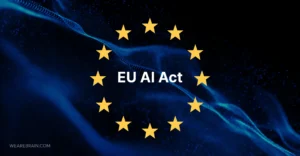
The EU AI Act isn’t coming, it’s already here. From February 2025, the AI Act will prohibit AI systems that present an unacceptable risk, including those that pose clear threats to people’s safety, rights, and livelihoods. While full enforcement starts in August 2026, the clock is already ticking for businesses using AI across Europe.
This isn’t just another regulatory hurdle. The AI Act is a European regulation on artificial intelligence (AI) – the first comprehensive regulation on AI by a major regulator anywhere. Like GDPR before it, what happens in Europe rarely stays in Europe.
The reality of AI regulation Europe
The AI Act introduces a risk-based approach, categorising AI systems into four risk levels: minimal, limited, high, and unacceptable. Think of it as a traffic light system—some AI gets a green light, others face red tape, and a few get banned outright.
Here’s what’s already in effect:
Prohibited AI systems are now banned. This includes the use of AI systems to determine or predict people’s emotions in workplace settings, with exceptions for safety reasons. Social scoring systems and manipulative AI techniques that could cause harm are also off-limits.
AI literacy requirements mean employees using AI systems need proper training. It’s not enough to have the technology—your team needs to understand how to use it responsibly.
The next major milestone hits this month (August 2025), when the governance rules and the obligations for GPAI models become applicable. General-purpose AI models—think ChatGPT-style systems—will face new transparency and safety requirements.
Industry pushback won’t slow things down
Over 45 leading European companies have urged the EU to pause the rollout of new regulations for high-risk and general-purpose AI systems, citing concerns about regulatory complexity and competitiveness. Major players like Siemens CEO Roland Busch see this legislation as a major reason why Europe is lagging, calling overlapping regulations “toxic” for digital business models.
But the European Commission isn’t budging. Commission Spokesperson Thomas Regnier was clear: “Let me be as clear as possible, there is no stop the clock. There is no grace period. There is no pause”. This firm stance means businesses can’t wait for regulatory relief that isn’t coming.
What EU AI Act compliance actually means
For many businesses, compliance starts with understanding what category your AI systems fall into. The Act doesn’t treat all AI equally—a chatbot for customer service faces different requirements than an AI system screening job applications.
High-risk AI systems include those used in critical infrastructure, education, employment, and law enforcement. These systems need extensive documentation, risk assessments, and human oversight.
General-purpose AI models have their own set of rules coming in August 2025. Every GPAI provider must keep a private “black-box” dossier that shows regulators exactly how the model was built and tested; publish a short, public summary of the copyrighted material used for training.
The penalties are real. Non-compliance attracts administrative fines of up to €15 million or 3% of global turnover (rising to €35 million / 7% for prohibited practices).
AI Act implementation timeline you can’t ignore
The phased approach means different rules kick in at different times:
- February 2025 (now active): Prohibited AI practices banned, AI literacy requirements
- August 2025: GPAI model obligations, governance structures, penalty framework
- August 2026: Full application of remaining provisions
- August 2027: Extended rules for high-risk systems in regulated products
Despite this structured timeline, implementation is encountering delays. The Commission has indicated that some key deliverables may be postponed, but the core obligations remain unchanged.
Practical steps for businesses
Don’t wait for perfect clarity—start with what you know. Begin by mapping your current AI usage. Many companies discover they’re using more AI than they realised, from automated customer support to predictive analytics.
- Assess your risk profile. The AI Act Compliance Checker can help give an indication about what obligations your system might face, though it’s no substitute for proper legal analysis.
- Document everything. Whether your AI qualifies as high-risk or not, good documentation helps prove compliance and makes audits smoother.
- Train your teams. The AI literacy requirements aren’t just a checkbox—they’re about ensuring people understand the implications of the AI they’re using.
- Plan in advance. If you’re developing or using general-purpose AI models, the GPAI rules will affect you directly. The final General-Purpose AI (GPAI) Code of Practice alongside FAQs provides voluntary but recommended compliance guidance.
Why compliance creates competitive advantage
While competitors struggle with regulatory uncertainty, prepared businesses can use compliance as a differentiator. Customers increasingly prefer working with companies that can demonstrate responsible AI use.
Early preparation also means avoiding the rush. As the transition period approaches, consultants and compliance services will become more expensive and harder to secure.
The Act also creates clearer market rules. Once everyone plays by the same standards, competition shifts back to innovation and execution rather than regulatory arbitrage.
Looking ahead
AI legislation is being developed across the world. According to the May 2025 Global AI legislation tracker countries around the world are developing and implementing AI governance legislation and policies. Europe may be first, but it won’t be last.
The businesses that master EU AI Act compliance now will be better positioned for global expansion as other regions develop similar frameworks.
The EU AI Act represents a fundamental shift in how we think about AI governance. Rather than seeing it as a burden, smart businesses are treating compliance as a competitive advantage and a stepping stone to sustainable AI adoption.
The question isn’t whether you’ll need to comply—it’s whether you’ll be ready when the deadlines hit.
Ready to assess your AI compliance strategy? Our team helps businesses navigate complex regulatory landscapes while maintaining their competitive edge. Let’s discuss how to turn compliance into an advantage for your business.
